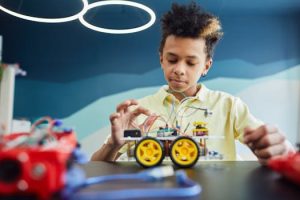The Role of Makerspaces in Fostering Innovation and Creativity
In today’s fast-paced and constantly evolving world, innovation and creativity are more important than ever. As industries become increasingly competitive, organizations are constantly seeking new ways to stay ahead of the game. This is where makerspaces come in. Makerspaces are collaborative workspaces that provide access to tools, technology, and resources for individuals to create, invent, and learn. These spaces have been gaining popularity in recent years, and for good reason. They play a crucial role in fostering innovation and creativity, which are essential for success in the modern world.
What are Makerspaces?
Before we dive into the role of makerspaces in fostering innovation and creativity, let’s first understand what makerspaces are. Makerspaces are community spaces that provide tools, equipment, and resources for individuals to create, build, and learn. They can range from small workshops in schools to large, fully-equipped facilities in libraries or community centers. These spaces are open to people of all ages and backgrounds, making them a hub for collaboration and knowledge sharing.
Tools and Technology
One of the primary reasons makerspaces are able to foster innovation and creativity is because of the access they provide to tools and technology. These spaces typically have a wide range of equipment and tools, such as 3D printers, laser cutters, and woodworking tools, which may not be easily accessible to individuals in their everyday lives. Having access to these tools allows people to bring their ideas to life in a tangible way, leading to the development of new and innovative products, services, and solutions.
Learning and Collaboration
Makerspaces also provide a unique learning and collaborative environment. These spaces bring together individuals from different backgrounds and skillsets, providing a fertile ground for idea generation and learning from one another. Makerspaces often have workshops, classes, and events where experts and enthusiasts can share their knowledge and skills with others. By encouraging collaboration and knowledge sharing, makerspaces can spark creativity and push individuals to think outside the box.
Inclusivity and Diversity
Another crucial aspect of makerspaces is their promotion of inclusivity and diversity. These spaces are open to people of all ages, backgrounds, and skillsets, making them a melting pot of ideas and perspectives. This inclusivity and diversity foster new ways of thinking and problem-solving, leading to the development of innovative and creative solutions. Makerspaces also help break down traditional barriers to entry in certain industries, making it easier for underrepresented individuals to pursue their interests and turn their ideas into reality.
Real-World Applications
The impact of makerspaces on fostering innovation and creativity is not just theoretical; it has real-world implications. Many successful companies and products have emerged from the ideas generated in makerspaces. For example, the popular card game “Cards Against Humanity” was created in a makerspace, as were some of the early prototypes of the Oculus Rift virtual reality headset. These examples demonstrate the potential of makerspaces to drive innovation and creativity that can lead to real-world successes.
Conclusion
In conclusion, makerspaces are playing a vital role in fostering innovation and creativity. These spaces provide access to tools and technology, promote collaboration and learning, and encourage inclusivity and diversity. As more industries and organizations recognize the value of these spaces, we can expect to see even more innovative and creative ideas emerge. So whether you’re a student, entrepreneur, or simply someone with a passion for creating, consider checking out your local makerspace and see how it can help fuel your own innovation and creativity.








